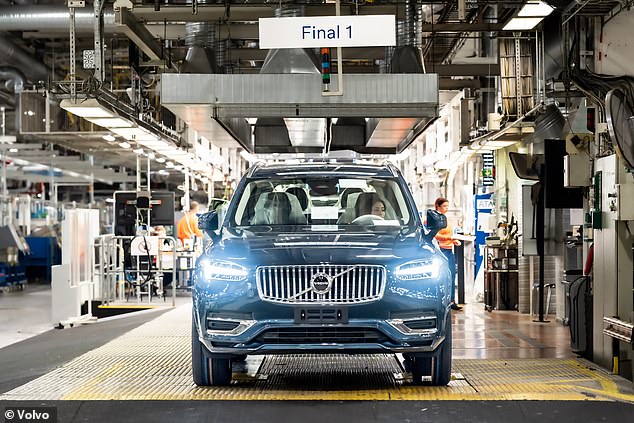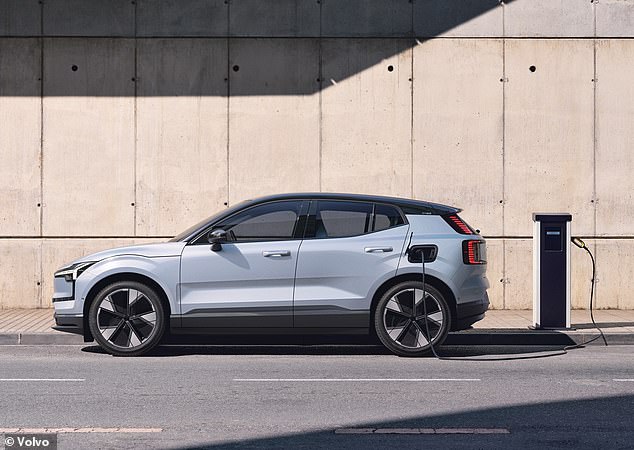Swedish car maker Volvo has produced its final diesel car as it accelerates towards an electric future.
Its last diesel ever is an oil-burning example of its XC90 SUV that came off its assembly line in Toslanda, Sweden, on Tuesday 26 March.
In a statement – in which Volvo said ‘goodbye diesel, hello electric’ – the brand dubbed the moment a ‘huge milestone’ in its 97-year history and a ‘big step’ towards becoming a fully electric car maker from 2030.

Diesel no more: Volvo has confirmed that this XC90 – produced at its Toslanda factory in Sweden on 26 March – is officially the last diesel car it will ever make
It confirms the end of 45-year diesel bloodline for Volvo and officially makes it the first major ‘legacy’ car maker to complete ditch diesel powertrains for good as it switches its attention to EVs.
And transition has gathered significant pace in the last five years.
Volvo says that back in 2019, diesel was its ‘bread and butter’ and represented the ‘majority’ of its cars sold in Europe.
However, by 2022 just 8.9 per cent of new Volvos were diesels.
In contrast, seven in 10 of its new models sold on the continent last year were fully electric, as the manufacturer looks to separate itself from the ‘dirty’ diesel image and lead the way in the EV revolution.
The announcement confirmed a commitment Volvo made during last year’s Climate Week event in New York that it would terminate diesel outputs for once and for all in 2024.

The last diesel Volvo – a blue 2.0-litre XC90 – won’t be sold to the public. Instead, it will be displayed at the new World of Volvo museum in Göteborg, which is due to open to the public on 14 April

Volvo turns its back on diesel: The Swedish car maker is officially the first ‘legacy’ vehicle manufacturer to entirely ditch oil-burning engines

Volvo says that 7 in 10 new models it sold in Europe last year were EVs, as the company looks to accelerate towards its ambition of being an electric-only car maker by 2030. Pictured: the electric Volvo EX30
‘For a long time, our diesel engines were synonymous with reliability and efficiency, and they meant a great deal to us for many decades. Indeed, the success of our diesel cars played a significant role in our evolution into a premium brand,’ the company said.
‘In recent years, the electric revolution has evolved quicker than most of us could have imagined – and it’s largely propelled by tightening regulations around tailpipe emissions, as well as customer demand in response to the climate crisis and a desire for cleaner urban air.’
The last diesel Volvo – a blue 2.0-litre XC90 – won’t be sold to the public.
Instead, it will be displayed at the new World of Volvo museum in Göteborg, which is due to open to the public on 14 April.
While it means customers across Europe will soon no longer be able to get their hands on a new Volvo oil burner, this has been the case in Britain for a matter of months.
This is because Volvo UK removed diesel-engined cars from its showrooms back in September.
The company continues to offer plug-in and mild-hybrid models, which it says ‘act as a perfect bridge’ towards its plans to sell only EVs from 2030.
Volvo will now embark on refitting its factories for EV manufacturing and the production of battery drivetrains.

How much have diesel car sales plummeted in the last decade? In 2013, one in two new motors registered were oil burners. Last year, that ratio fell to fewer than one in 13
Decade demise of diesel
The fall in demand for diesel cars has been well documented in recent years.
Since the diesel emissions cheating scandal hit front pages in 2015, sales of oil burners have gone into reverse.
In 2013, 49.8 per cent [yes, half!] of all new cars registered were diesels.
That was more than petrols (48.8 per cent) while ‘alternative fuel vehicles’ – both hybrids and electric vehicles (EVs) combined – represented the remaining 1.4 per cent of sales 10 years ago.
Official registration figures published by the Society of Motor Manufacturers and Traders (SMMT) show that a mere 7.5 per cent of new car sales were diesels last year – that’s fewer than one in 13 motors entering the road, down from one in two a decade earlier.
Despite the huge decline in diesel appetite, petrols retain at a similar market share as they did in 2013 as a consequence of a dramatic uptake of hybrids and EVs.
Unleaded-powered models made up 47.4 per cent of registrations last year, which is 1.4 percentage points down on a decade ago.
As such, the rise in greener vehicle sales means the average CO2 emission output for new cars has fallen by 15 per cent from 128.3g/km in 2013 to 108.9 last year.
Some links in this article may be affiliate links. If you click on them we may earn a small commission. That helps us fund This Is Money, and keep it free to use. We do not write articles to promote products. We do not allow any commercial relationship to affect our editorial independence.



